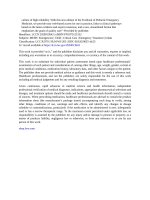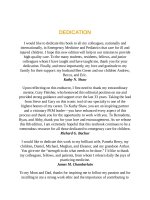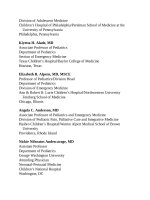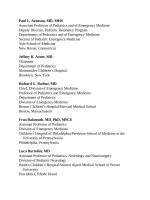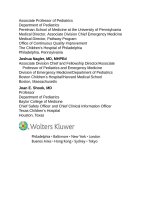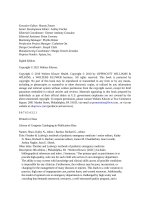Pediatric emergency medicine trisk 0828 0828
Bạn đang xem bản rút gọn của tài liệu. Xem và tải ngay bản đầy đủ của tài liệu tại đây (99.51 KB, 1 trang )
TABLE 41.2
MODIFIED COMA SCALE FOR INFANTS
Activity
Best response
Eye opening
Spontaneous
To speech
To pain
None
Coos, babbles
Irritable, cries
Cries to pain
Moans to pain
None
Normal spontaneous
movements
Withdraws to touch
Withdraws to pain
Abnormal flexion
(decorticate rigidity)
Abnormal extension
(decerebrate rigidity)
None
Verbal
Motor
Score
4
3
2
1
5
4
3
2
1
6
5
4
3
2
1
Cranial nerve function is assessed by checking for facial symmetry, corneal
reflexes, presence of a gag reflex, full extraocular movements, pupillary size, and
pupillary reactivity. In the comatose patient or in the child with possible neck
injury who is uncooperative, lateral gaze may be tested by caloric stimulation of
the vestibular apparatus (but not the “doll’s eye” maneuver) once tympanic
membrane integrity has been established.
Examination of the motor system to evaluate both CNS and spinal cord
function varies with age and level of consciousness. The alert patient should have
individual muscle groups tested and gait evaluated. The child with a depressed
level of consciousness may have motor responses elicited by noxious stimuli
(e.g., sternal rub, nail bed pressure). Deep tendon reflexes and Babinski response
